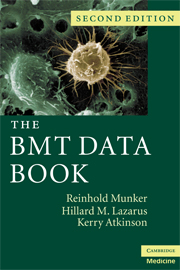Book contents
- Frontmatter
- Contents
- List of contributors
- Foreword
- Preface
- Acknowledgments
- Section 1 Basic science
- Section 2 Hematologic malignancies
- Section 3 Solid tumors
- Section 4 Nonmalignant disorders
- Section 5 Practical aspects and procedures
- Section 6 Complications
- Section 7 The BMT/SCT pharmacopoeia
- Section 8 HLA-testing and laboratory medicine
- Appendix
- Index
Foreword
Published online by Cambridge University Press: 31 July 2009
- Frontmatter
- Contents
- List of contributors
- Foreword
- Preface
- Acknowledgments
- Section 1 Basic science
- Section 2 Hematologic malignancies
- Section 3 Solid tumors
- Section 4 Nonmalignant disorders
- Section 5 Practical aspects and procedures
- Section 6 Complications
- Section 7 The BMT/SCT pharmacopoeia
- Section 8 HLA-testing and laboratory medicine
- Appendix
- Index
Summary
It is over 50 years since the basic concepts underpinning bone marrow transplantation were revealed in radiation protection experiments in mice. It seems curious to us now that in the 1950s the idea that marrow cells could grow and reconstitute hematopoiesis in an irradiated recipient was so revolutionary that it took careful experiments to prove the “cellular theory” and disprove the “humoral theory” of radiation protection. Equally remarkable is the fact that within a few years of this (and at a time before we knew what the thymus did or that lymphocytes could be divided into B and T cell subsets) the unique transplant-associated phenomena of graft-versus-host disease, graft-versus-leukemia and graft rejection were recognized as alloresponses. Fast forward to today; bone marrow transplantation has become stem cell transplantation (SCT) and the complexity of the field has increased exponentially as we define transplant biology increasingly at the molecular level. SCT is a treatment being continually extended to new malignant and nonmalignant diseases. More transplants are being performed, not only because more unrelated donor stem cell sources are available but also because mismatched transplants are beginning to be used more safely. As the mortality from transplant has fallen, SCT is applied increasingly to older and debilitated individuals. Luckily, expertise in the clinical SCT community has kept pace with this expanding field. There has been a general increase in transplant “know how” and many procedures are now standardized worldwide.
- Type
- Chapter
- Information
- The BMT Data Book , pp. xi - xiiPublisher: Cambridge University PressPrint publication year: 2009



